Wolfram Notebook is definitely my choice, because it is a story within a story within a story... - what I mean by this I'll explain in the end. Wolfram Notebook is the first thing I open, when I want to record ideas, poke at data, experiment, explore, get creative, make beautiful things :-), etc. (For instance, all my blogs, were written in a Wolfram Notebook from scratch - take a look :-) )
Before I came to Wolfram I was a math / physics professor at City University of New York and was using Mathematica extensively for research and teaching, and even before that as student. I remember in 2007 version 6 came out and I first saw Manipulate and Dynamic etc. and it blew my mind. That was powerful for my work, but most importantly it was not "just" a feature of frontend - it was introduced as part of Wolfram Language. Then I understood this company brings real innovative solutions. Not long after I came to Wolfram as I believed they do some cool stuff. So partly notebook story changed my career.
There are many various arguments that were brought up through decades by various people about this topic. But instead of repeating a tone of things I'd rather point you to some recent pages Wolfram designed specifically to outline advantages.
Also I'd recommend reading these relevant Stephen Wolfram blogs:
and also checking out these very recent resources (in addition to those numerous ones mentioned in first 2 links above):
BTW, on a somewhat related note, we have recently introduced Wolfram Notebook Embedder, which adds more integration with other media:
https://reference.wolfram.com/language/WolframNotebookEmbedder
This is an example of it: Biodiversity: The Computational Pumpkin
So, to conclude, let's take as an example one of many advantages: "Wolfram Notebook is great for computational exploration because it comes with built-in algorithms." True, but is it the whole story? No, because actually it includes connection to roughly this number of various symbols and algorithms:
In[]:= WolframLanguageData[]//Length
Out[]= 5436
which is huge, from basic like Sort to deeply complex like NDSolve, covering highly diverse fields of human knowledge -- it's one of the most unique existing programing languages. Then additionally you got Wolfram Function Repository connection, packages, links to other languages like JLink, NETLink, etc. Same with "data in document" advantage. Not only you have, for instance, built-in data -- this data comes from enormous Wolfram|Alpha base, which is a company itself. But then you also got a sea of Import/Export data formats, ability to write your own importers for exotic data, etc. - so much flexibility and integrity! And same goes for "interactivity" where that word actually means a whole part of Wolfram Language dedicated to creation of dynamic interfaces and applications. Same for "visualizations", and so on.
So that's "a story within a story within a story" meaning -- it is all about integrity and diversity of features that come with your report environment. And while things do keep developing and improving, I have never experienced anything as complete and smooth as a Wolfram Notebook. It helps me to write as I think elaborate technical things - quickly and fluently.


But really about ad-hoc documents or "quick and not-so-dirty" internal memosFor this, I suppose Mathematica is fine. Just like using word for a quick note to send to someone. I myself, would still use Latex :) one advantage of Latex, you can get both PDF and HTML from same source. Mathematica export to HTML and PDF are not as good. $\endgroup$